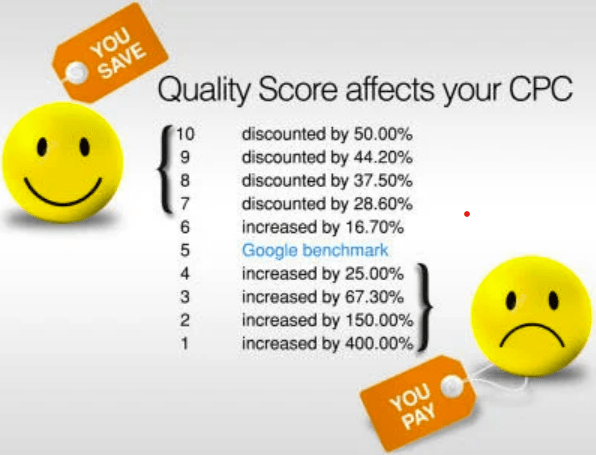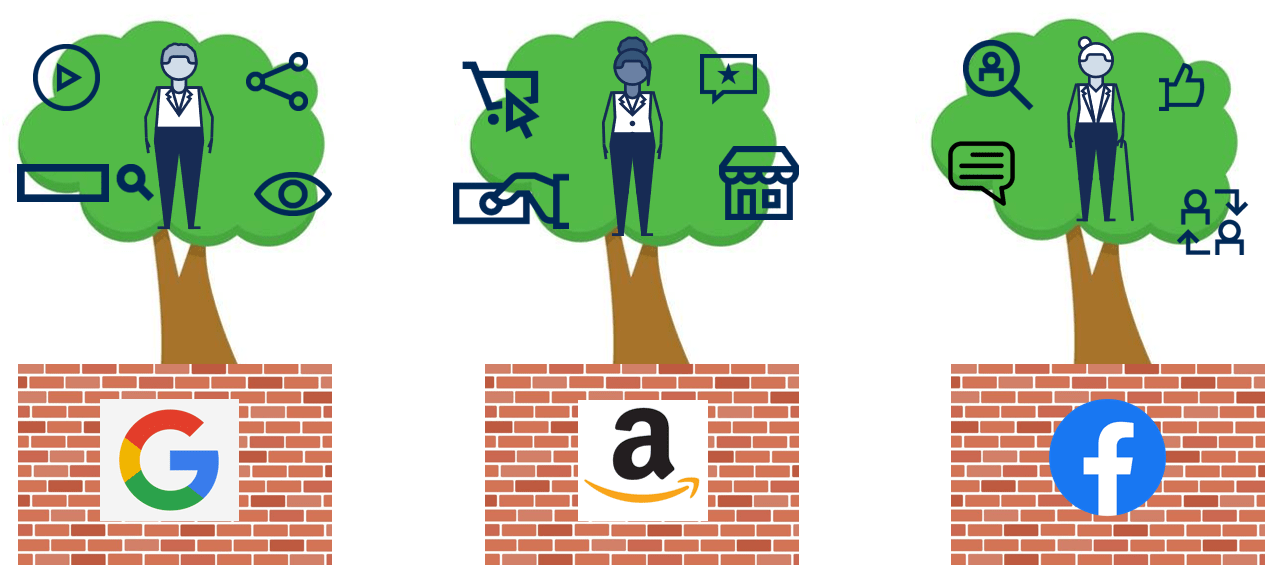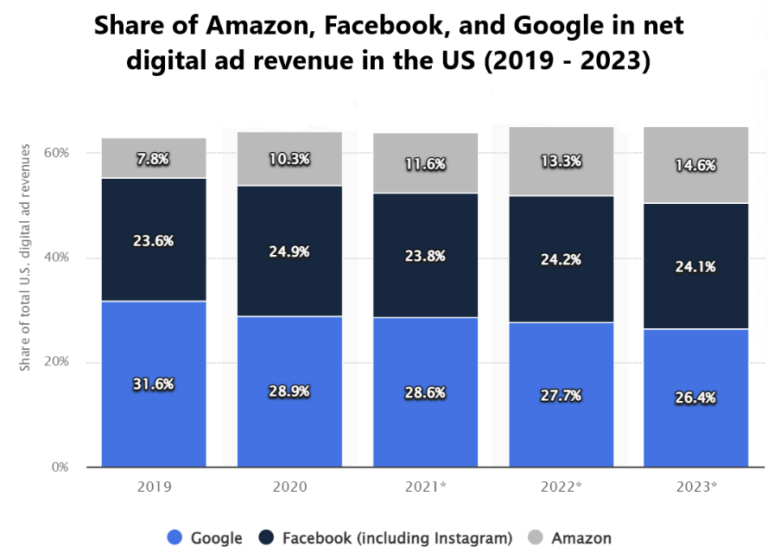Digital ads are an essential part of every company’s marketing efforts. Unfortunately, you may not be getting the full view of your data because of the ad platform’s walled garden.
Expected to drive $565.20 billion in 2022, digital advertising accounts for 64.2% of all ad spending. For advertisers, digital media offers an average return on investment (ROI) of $5 per $1 spent.
Therefore, almost half of small businesses consistently invest in digital ads on a weekly basis, and an impressive 93% of them are planning to increase their spending as of June 2021.
We’ll help you understand the challenges of running paid ads in today’s walled gardens. We’ll also discuss effective ways to optimize your digital ads and grow your business inside these walls.
Digital Ads and How Walled Gardens Limit Critical Data
To be able to make the most of this marketing tactic, you need to know the available digital advertising options and their respective limitations.
Walled gardens occupy more than half of the digital advertising landscape. The most prominent examples that we’ve all heard about are Meta (formerly Facebook), Google, and Amazon. Known as the digital ad triopoly, these three giants hold a total digital ad revenue share of 65.2%.
What can you expect from advertising in walled gardens?
The digital environment has caused anxiety of losing personal privacy due to the vast amounts of customer data collected during online interactions. To ensure compliance, large digital advertising platforms have developed user data aggregations that can be used by advertisers to test and target their marketing messages.
What does this mean for you and your business?
You can target your ads based on other businesses’ experiences but you won’t gain detailed visibility into the results of your own campaigns and you won’t own the data gathered during running your ads. This helps you maintain regulatory compliance while using extensive pools of customer data.
Another challenging aspect of advertising with walled garden platforms is that they don’t encourage the use of a third-party service to help guide and optimize your work. However, these platforms offer a great range of in-house solutions and tools that enable you to create your ads. So, you can buy spots on the Meta Ad Platform and display them on any or all the other Meta owned platforms, but not on those outside their universe like Google Ads.
Also, the walled garden facilitates your presence across all their platforms and lets you reach larger audiences. Using the capabilities of the platforms, you can better target your digital ad, so that it can be displayed to people that are closer to your ideal buyer persona.
The Challenges of Digital Ads Within the Walls
The main challenge when advertising within the a walled garden environment is selecting the right audience for your message. The proper marketing segmentation is essential for the success of your campaign. At the same time, failing to target your ads precisely can result in excessive spending and a reduced ROI.
Also, walled gardens create an extremely competitive landscape, which makes it increasingly difficult for businesses to stand out and get the audience’s attention. YouTube, for example, has become an overcrowded space that features 500+ hours of video uploads per minute.
Transparency is another problem. With limited access to your ad performance and details, it’s hard to analyze the particular elements that need improvement.
Let’s go further into the individual walled gardens dominating today’s digital media and their advertising challenges.

Google and YouTube
Google makes it difficult to find the right keywords that will ensure the visibility of your ad. It may be difficult to optimize campaigns by yourself, especially when it comes to split-testing your ad copy, pausing low-performing keywords, and testing new ones.
When running video advertising on YouTube, cutting costs by using lower-quality videos can dramatically decrease your impressions. Monetizing your ads requires high quality videos or the platform will punish you (quality score).
Facebook and Instagram
To run a successful Facebook ad campaign, you need to keep a close eye on the way your audience interacts and responds to it. Without constantly tracking the performance metrics of your ad and optimizing it accordingly, you won’t be able to drive conversions and control advertising expenses.
On the other hand, Instagram places special attention on hashtags as a means of targeting particular groups and interests. Knowing which hashtags and how many to use is important for post performance.
Amazon
Amazon is an ever-changing walled garden where rules cannot be predicted. It continuously adds new regulations making it difficult to stay up-to-date. In addition, it’s often difficult to keep track of your competitors.
LinkedIn and Bing Ads
Among the challenges that LinkedIn poses are the lower degree of customizability and the difficulty of optimizing ad objectives when duplicating your ads.
With 85% of its users located in the US, Bing Ads works very effectively in country. However, you may need to pay closer attention if you advertise to other countries. Also, its efficiency varies across industries and age groups, which makes it a less universal solution requiring more research on the part of advertisers.
Knowing the challenges of each platform can help you prepare your targeting. But, what options are outside these walls?
Among the challenges that LinkedIn poses are the lower degree of customizability and the difficulty of optimizing ad objectives when duplicating your ads.
With 85% of its users located in the US, Bing Ads works very effectively in country. However, you may need to pay closer attention if you advertise to other countries. Also, its efficiency varies across industries and age groups, which makes it a less universal solution requiring more research on the part of advertisers.
Knowing the challenges of each platform can help you prepare your targeting. But, what options are outside these walls?

Independent Ad Tech
These are providers that offer diverse advertising technologies and platforms outside the walled gardens, such as MediaMath, LiveRamp, OpenX, Pubmatic, Index Exchange, and The Trade Desk.
They deliver programmatic development services that can help businesses build:
- Ad servers, networks, and exchanges
- Demand and supply-side platforms (DSPs and SSPs)
- Data and consent-management platforms (DMPs)
- New media-buying processes added to their platforms
Using independent ad tech companies can bring improved visibility through freer access to data, measurement, and attribution. They also ensure user data ownership and better customer support.
This is a great solution for large publishers and advertisers that have dedicated digital advertising departments and can take all benefits offered by running in-house platforms and services.
How to Thrive Inside the Walled Gardens
- Here are some practical tips that can work for your business:
1. Align your ad with the platform requirements
2. A/B Test Ad Performance:
- Optimize a single element at a time
- Regularly track the results and optimize
3. A/B Test Platform Performance
- Run the same digital ad on the different platforms, setting the same target audience, budget, and objectives: This will enable you to gain insights into what works best in each.
- Regularly track the results: Without tracking performance you won’t be able to pinpoint your ad weaknesses.
- Optimize your ads in the same manner across the platforms
- Implement these procedures regularly: Repeat weekly or in regular intervals so you can change the elements that need improvement.
Get Expert Help if Needed
Outsourcing to an ad specialist can make it easier for you to identify the challenges of each platform and respond to them effectively. Often, specialists focus on one platform or another. To work across many platforms without using a independent ad company or system you can work with an agency.
By leveraging professional expertise, you can keep your paid ad expenses in control and increase the ROI of your digital advertising activities. Investing your time and energy in improving your products and services while ensuring ad campaign success will help you thrive and stay on top of the competition.


